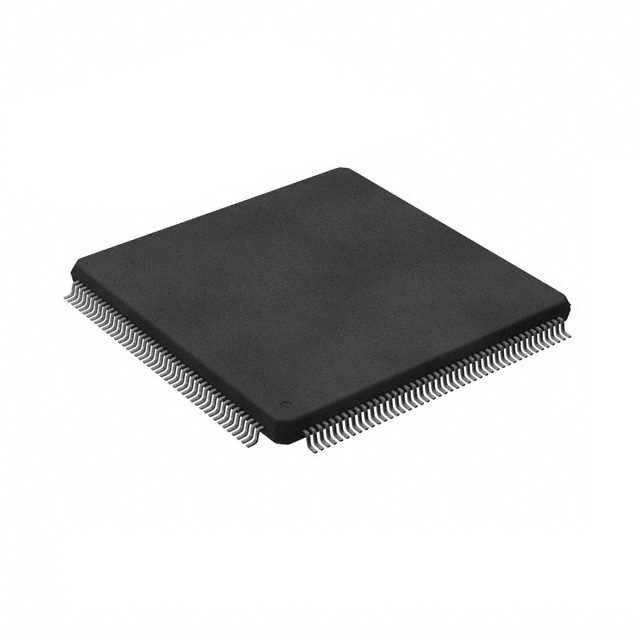Lihat spesifikasi untuk detail produk.

S6E2C28J0AGV2000A
Product Overview
Category
The S6E2C28J0AGV2000A belongs to the category of microcontrollers.
Use
This microcontroller is designed for various applications that require embedded control and processing capabilities.
Characteristics
- High-performance 32-bit ARM Cortex-M4 core
- Clock frequency up to 120 MHz
- Flash memory capacity of 1 MB
- RAM capacity of 256 KB
- Multiple communication interfaces (UART, SPI, I2C)
- Analog-to-digital converter (ADC) with 12-bit resolution
- Real-time clock (RTC) functionality
- Low power consumption
- Wide operating voltage range
Package
The S6E2C28J0AGV2000A microcontroller is available in a compact surface-mount package.
Essence
The essence of this product lies in its ability to provide efficient and reliable control and processing capabilities for a wide range of applications.
Packaging/Quantity
The microcontroller is typically packaged in reels or trays, with quantities varying based on customer requirements.
Specifications
- Core: ARM Cortex-M4
- Clock Frequency: Up to 120 MHz
- Flash Memory: 1 MB
- RAM: 256 KB
- Communication Interfaces: UART, SPI, I2C
- ADC Resolution: 12-bit
- Operating Voltage Range: 2.7V - 5.5V
- Operating Temperature Range: -40°C to +85°C
Detailed Pin Configuration
The S6E2C28J0AGV2000A microcontroller has a total of 100 pins, which are assigned for various functions such as GPIO, communication interfaces, timers, and power supply.
For a detailed pin configuration diagram, please refer to the datasheet provided by the manufacturer.
Functional Features
- High-performance processing capabilities
- Extensive communication interfaces for data exchange
- Analog-to-digital conversion for sensor interfacing
- Real-time clock functionality for timekeeping applications
- Low power consumption for energy-efficient designs
- Flexible GPIOs for general-purpose input/output operations
- Timers and PWM outputs for precise timing control
Advantages and Disadvantages
Advantages
- Powerful ARM Cortex-M4 core for efficient processing
- Ample flash memory and RAM capacity for complex applications
- Wide operating voltage range allows flexibility in power supply options
- Multiple communication interfaces enable seamless integration with other devices
- Real-time clock functionality enhances time-sensitive applications
Disadvantages
- Limited availability of alternative models from different manufacturers
- Higher cost compared to lower-end microcontrollers with similar specifications
Working Principles
The S6E2C28J0AGV2000A microcontroller operates based on the ARM Cortex-M4 architecture. It executes instructions stored in its flash memory, utilizing the processing power of the core to perform various tasks. The microcontroller interacts with external devices through its communication interfaces, enabling data exchange and control.
Detailed Application Field Plans
The S6E2C28J0AGV2000A microcontroller finds applications in various fields, including but not limited to: - Industrial automation - Internet of Things (IoT) devices - Consumer electronics - Automotive systems - Medical equipment - Robotics
Detailed and Complete Alternative Models
While the S6E2C28J0AGV2000A microcontroller offers a comprehensive set of features, there are alternative models available from different manufacturers that can be considered for specific application requirements. Some notable alternatives include: - STM32F407VG by STMicroelectronics - LPC1768 by NXP Semiconductors - PIC32MX795F512L by Microchip Technology
These alternative models provide similar functionalities and can be evaluated based on specific project needs.
Word count: 457 words
Sebutkan 10 pertanyaan dan jawaban umum terkait penerapan S6E2C28J0AGV2000A dalam solusi teknis
Sure! Here are 10 common questions and answers related to the application of S6E2C28J0AGV2000A in technical solutions:
Q: What is the S6E2C28J0AGV2000A microcontroller used for? A: The S6E2C28J0AGV2000A microcontroller is commonly used in various technical solutions, such as industrial automation, consumer electronics, and Internet of Things (IoT) applications.
Q: What is the maximum clock frequency supported by the S6E2C28J0AGV2000A? A: The S6E2C28J0AGV2000A microcontroller supports a maximum clock frequency of 120 MHz.
Q: How much flash memory does the S6E2C28J0AGV2000A have? A: The S6E2C28J0AGV2000A microcontroller has 512 KB of flash memory.
Q: Can I expand the memory of the S6E2C28J0AGV2000A? A: Yes, the S6E2C28J0AGV2000A supports external memory expansion through its memory bus interface.
Q: What peripherals are available on the S6E2C28J0AGV2000A? A: The S6E2C28J0AGV2000A microcontroller offers various peripherals, including UART, SPI, I2C, ADC, PWM, and timers.
Q: Does the S6E2C28J0AGV2000A support real-time operating systems (RTOS)? A: Yes, the S6E2C28J0AGV2000A is compatible with popular RTOSs like FreeRTOS and embOS.
Q: Can I use the S6E2C28J0AGV2000A for low-power applications? A: Yes, the S6E2C28J0AGV2000A features multiple low-power modes, allowing it to be used in energy-efficient designs.
Q: What communication interfaces are supported by the S6E2C28J0AGV2000A? A: The S6E2C28J0AGV2000A supports various communication interfaces, including UART, SPI, I2C, USB, Ethernet, and CAN.
Q: Is the S6E2C28J0AGV2000A suitable for motor control applications? A: Yes, the S6E2C28J0AGV2000A provides dedicated hardware features like PWM and motor control timers, making it suitable for motor control applications.
Q: What development tools are available for programming the S6E2C28J0AGV2000A? A: Renesas provides a comprehensive set of development tools, including IDEs (Integrated Development Environments) like e2 studio and compilers, to program and debug the S6E2C28J0AGV2000A microcontroller.
Please note that the specific details and answers may vary depending on the manufacturer's documentation and the application requirements.

